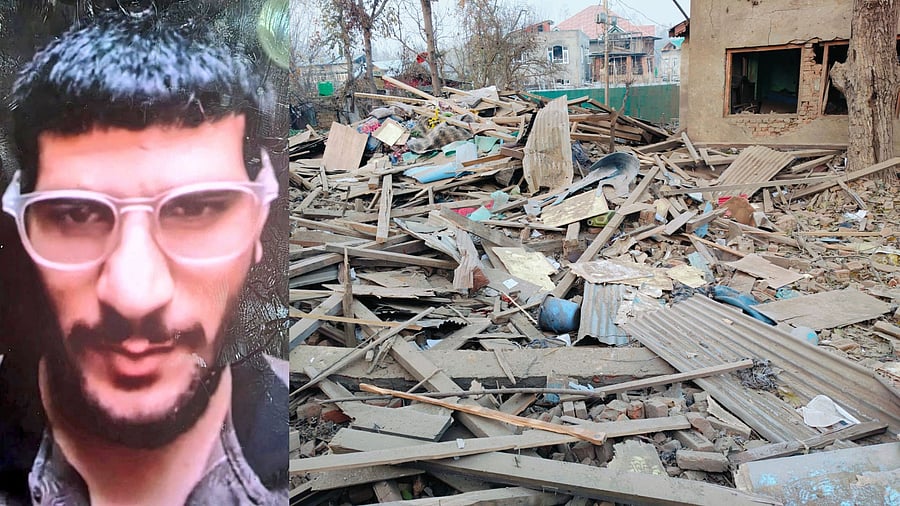
Dr Umar Nabi (left) and the remains of the demolished house.
Credit: Screengrab
Srinagar: Security forces demolished the Pulwama residence of Dr Umar Nabi, the prime accused in the Red Fort blast, using a controlled explosion—marking yet another escalation in Jammu and Kashmir’s ongoing campaign against terror networks following this year’s devastating Pahalgam attack.
The demolition was carried out during the intervening night of Thursday and Friday. Officials said the two-storey house in Koil village was brought down after investigators concluded that Umar, a medical professional by training, played the central role in the November 10 car bombing outside Red Fort in which a white Hyundai i20 packed with explosives detonated, killing at least 13 people and injuring several others.
Umar's identity was confirmed after DNA samples collected from the blast site matched with those of his mother. Reports said the demolition was carried out past midnight with the area sealed off and additional security deployed to prevent any spillover effects.
According to investigators, forensic reconstruction of the Delhi blast, CCTV imagery placing Umar behind the wheel moments before detonation, and subsequent digital tracing of his movements formed the basis for the crackdown on his assets in Kashmir.
Officials said that Umar, once regarded as a bright, academically driven doctor in his community, appeared to have drifted toward hard-line beliefs over the past two years. They found he had joined multiple radical messaging groups on social platforms.
The action comes in the shadow of the April 22 Pahalgam massacre—one of the deadliest attacks on civilians in recent years—when 25 tourists and a local villager were killed in a terror strike in the Baisaran Valley.
In its aftermath, security forces launched sweeping counter-terror operations across south Kashmir. Through May 2025, more than a dozen residential houses, suspected hideouts and safe structures used by terrorists were blasted in targeted operations in Pulwama, Shopian and Kulgam as part of what officials described as an “uncompromising dismantling of the support ecosystem”.
Many of those demolitions involved structures belonging to active militants or families believed to have knowingly facilitated shelter, logistics or transport for outlawed groups.
Officials said Thursday night’s demolition fits into the same template—zero tolerance towards properties allegedly used for harbouring militants or aiding terror activity.
They added that the Red Fort blast probe has revealed a pattern of “white-collar radicalisation” where educated professionals, including doctors and students, have increasingly been used by Pakistan-based handlers to execute high-impact attacks because of their mobility, clean records and social acceptability.
While civil society groups and political leaders have raised concerns over demolitions affecting families, security officials maintain that the method is used only when properties are proven to be directly linked to militant activity and when their continued use poses an operational threat.
With the Red Fort investigation widening and south Kashmir still on high alert, officials indicated that more targeted actions are likely in the coming days as agencies move to, in their words, “break the last mile of the terror infrastructure”.